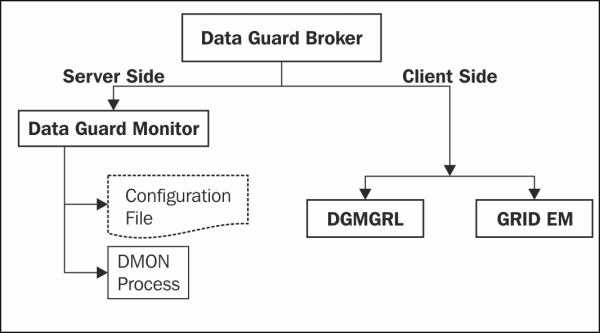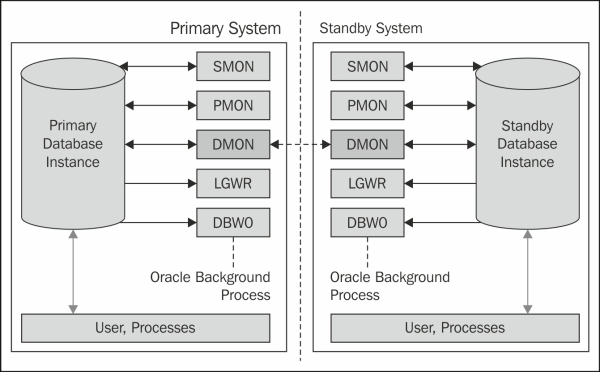We can divide the Data Guard broker components into two—client-side and server-side interfaces—as shown in the following diagram:

The components of the Data Guard broker are the Data Guard Monitor process and the configuration file, as shown in the following diagram:

The DMON is installed as part of the Oracle database software and manifests as a background component when enabled. The DMON process on the primary database is the owner of the configuration. DMON controls all the databases by using configuration files. It maintains profiles of all the database objects in the configuration in the form of a binary configuration file. The configuration is maintained by the DMON process in all the standby databases of either a physical or a logical configuration. This two-way communication channel is used to pass requests between databases, to monitor the health of all the databases in the broker configuration using Oracle Net Services. DMON runs for every database instance that is managed by the broker. Whenever a broker command is issued, the following steps will occur:
- The request will be processed on the primary database.
- The DMON process coordinates with all the standby databases of the Data Guard configuration.
- It then updates the changes, properties, and configuration in its configuration file.
- The DMON process contacts and updates the configuration file of each database in the setup.
The following diagram illustrates the DMON process:

The configuration file is a server-side component. Database profiles are stored in a configuration file that holds all the settings needed by Data Guard. This file holds the configuration information of all the databases that are part of the configuration, and the state of each database in the configuration. The broker configuration files in Oracle 11gR2 can now reside on disks having any sector size (physical block size) up to 4KB. The component coordinate database state transitions and updates database properties dynamically with the broker. The broker propagates the changes to all the databases and their server parameter files in the configuration. Oracle uses two configuration files to store the last-known good configuration settings during the modification of the configuration properties or state by the DMON process.
The Data Guard broker client-side components are the broker command-line interface (DGMGRL) and the Enterprise Manager Cloud Control client. Both utilities are used to manage Data Guard configurations consisting of primary and standby databases.
Using DGMGRL, you can change property values directly by using the command-line utility. It includes commands to create an observer process that monitors the whole configuration, including the primary and standby, to evaluate if a failover is necessary, and to initiate FSFO. It's also possible to add new standby databases to the configuration. Instead of managing primary and standby databases with various SQL*Plus statements, the broker provides a single, unified interface.
The Data Guard broker's parameter values must be changed by using broker interfaces. If the broker is active and you perform any parameter changes or role transitions by using SQL*Plus, it can create inconsistency in the configuration.
